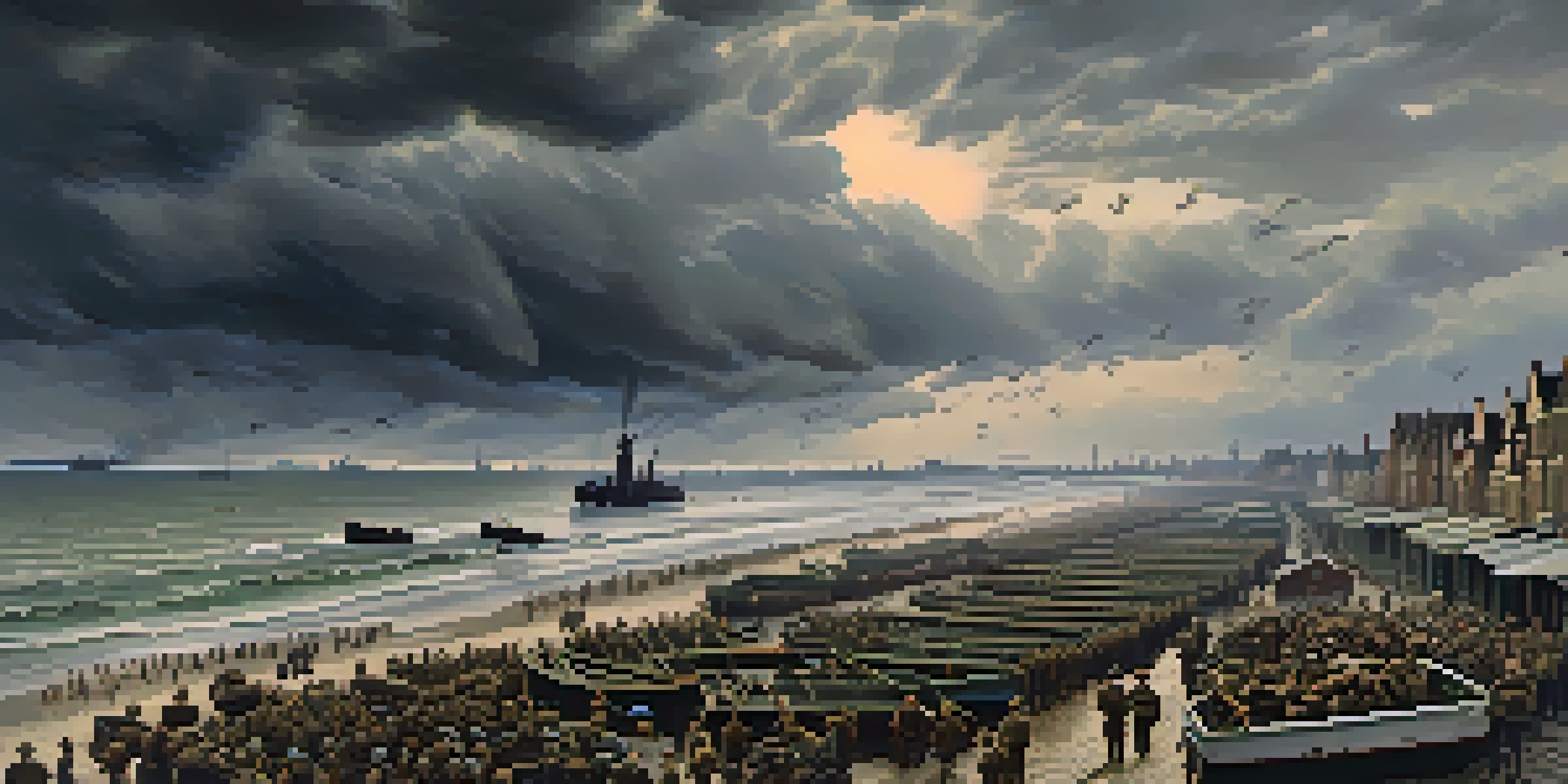A Review of 'Dunkirk': The Accuracy of World War II Events

Understanding the Historical Context of Dunkirk
The Dunkirk evacuation, known as Operation Dynamo, took place between May 26 and June 4, 1940. During this critical phase of World War II, Allied forces found themselves surrounded by German troops in the French coastal town of Dunkirk. The urgency of the situation made this evacuation essential to preserve the British Expeditionary Force. Christopher Nolan's film captures the tension and chaos of this moment in history.
In war, there are no unwounded soldiers.
Nolan adeptly weaves together individual stories set against the backdrop of a monumental military operation. This adds a personal touch to the historical events, allowing viewers to connect emotionally with the soldiers' plight. By focusing on the human experience, the film highlights the broader implications of Dunkirk on the war's trajectory.
While the film's portrayal is intense and immersive, it's important to remember that it is a dramatization. As with any historical film, artistic license is employed to enhance the narrative and emotional weight, prompting viewers to think critically about the line between fact and fiction.
Key Characters and Their Real-Life Counterparts
In 'Dunkirk,' several characters represent real individuals involved in the evacuation. For instance, the character of Mr. Dawson, played by Mark Rylance, embodies the civilian spirit of the Dunkirk evacuation, as many private boat owners participated in rescuing stranded soldiers. This portrayal emphasizes the collective effort of ordinary citizens during wartime.

However, while Dawson's character is fictional, he symbolizes the bravery and determination of those who risked their lives to save others. The film also features soldiers like Tommy and Gibson, who navigate the harrowing experience of evacuation, reflecting the broader experiences of countless men.
Dunkirk's Historical Significance
The Dunkirk evacuation was a critical moment in World War II, showcasing the bravery of Allied forces and the impact of civilian efforts.
It's crucial to recognize that while individual stories provide insight into the event, they cannot encapsulate the entire historical narrative. Thus, while the film brings attention to personal experiences, it may not fully represent the complexities of the evacuation.
The Role of Cinematic Techniques in Storytelling
Christopher Nolan employs innovative cinematic techniques to immerse the audience in the tension of Dunkirk. The use of non-linear storytelling allows viewers to experience different perspectives and timelines concurrently, heightening the suspense. This approach mirrors the chaos soldiers faced during the evacuation, making the film a more visceral experience.
History is written by the victors.
Additionally, the film's minimal dialogue emphasizes visual storytelling, forcing audiences to engage more deeply with the characters' emotions and struggles. The haunting score by Hans Zimmer further amplifies the feeling of urgency, drawing viewers into the heart of the action.
These techniques not only enhance the film's narrative but also serve to underscore the historical significance of Dunkirk. By blending engaging visual elements with authentic historical events, Nolan crafts a compelling story that resonates with audiences.
Exploring the Historical Accuracy of Depicted Events
While 'Dunkirk' is heralded for its realistic portrayal, certain liberties are taken for dramatic effect. The film compresses the timeline of the evacuation, suggesting events unfolded more swiftly than they actually did. In reality, the operation lasted nearly two weeks, filled with numerous complications and strategic challenges.
Moreover, the depiction of the Luftwaffe's relentless attacks emphasizes the urgency of the situation but might oversimplify the complexities of air support during the evacuation. The reality was a mix of successes and setbacks, and the film focuses on the most dramatic moments to maintain viewer engagement.
Cinematic Techniques Enhance Story
Christopher Nolan's use of non-linear storytelling and minimal dialogue immerses viewers in the tension and urgency of the Dunkirk evacuation.
Despite these artistic choices, the film largely succeeds in capturing the essence of the Dunkirk evacuation. It highlights the bravery of those involved and the dire circumstances they faced, even if some details are streamlined for cinematic purposes.
Reactions from Historians and Critics
Historians and critics have praised 'Dunkirk' for its commitment to depicting the events authentically, even if some creative liberties were taken. Many appreciate how the film brings attention to a pivotal moment in World War II that is often overshadowed by larger battles. By focusing on an event that showcased human resilience, it resonates with both history buffs and casual viewers alike.
However, some historians have pointed out areas where the film could have provided more context. For instance, the complexities of the military strategies and the political implications of the evacuation are downplayed, which could leave some viewers with an incomplete understanding of Dunkirk's significance.
Overall, the film has sparked discussions about the accuracy of historical representations in cinema, encouraging audiences to explore the real events beyond the film. This dialogue is essential in bridging the gap between entertainment and education.
The Impact of 'Dunkirk' on Popular Culture
'Dunkirk' has left a significant mark on popular culture, influencing how World War II narratives are portrayed in film and media. Its unique storytelling methods and immersive experience have set a new standard for war films. The film's success has reignited interest in the Dunkirk evacuation, prompting discussions and studies about this critical event.
Moreover, the film's haunting visuals and score have permeated other forms of media, inspiring documentaries and books that delve deeper into the history of Dunkirk. As a result, audiences are motivated to explore the real-life events that shaped the course of the war.
Cultural Impact of 'Dunkirk'
'Dunkirk' has influenced popular culture by reigniting interest in World War II narratives and prompting discussions about historical accuracy in film.
This cultural impact emphasizes the importance of historical films in educating and engaging the public. 'Dunkirk' has become more than just a film; it serves as a catalyst for further exploration of the complex narratives surrounding World War II.
Conclusion: Balancing Art and History in 'Dunkirk'
In summary, 'Dunkirk' stands as a remarkable achievement in filmmaking, skillfully blending art with historical events. While it takes certain liberties for the sake of storytelling, the film largely captures the essence of the Dunkirk evacuation and its emotional weight. The characters, cinematography, and sound design work together to create an unforgettable experience.
As viewers, it's essential to approach historical films with a critical eye, recognizing both the artistic interpretations and the factual underpinnings. 'Dunkirk' invites us to explore the complexities of history while still enjoying a gripping narrative.

Ultimately, the film serves as a reminder of the sacrifices made during wartime and the importance of preserving these stories. By balancing art and history, 'Dunkirk' has not only entertained but also educated audiences about a pivotal moment in World War II.